The Corporation's commitment to supporting the American culture of citizenship, service, and responsibility includes measuring the success and impact of our efforts. Performance reviews, research, and policy analysis help develop and cultivate knowledge that will enhance the overall effectiveness of the Corporation and of national and community service programs.
The Corporation conducts and supports high quality, rigorous social science evaluation research designed to:
In addition, the Web site contains links to a number of other useful resources -- including research reports, factors that influence volunteering (indicators that help a state or city understand why their volunteer rate might be higher or lower than another state or city), and effective practices. Additionally, you can find at the site a new issue brief that analyzes the volunteering landscape in America in the midst of a challenging economic climate. All of these materials are designed to help local nonprofit leaders target their recruiting efforts more effectively, match local programs with available volunteer resources, fill service gaps, and do a better job of retaining their volunteers.
With funding from the Corporation for National and Community Service (CNCS), Abt Associates conducted the National Evaluation of Youth Corps (NEYC). The study was a multi-phased assessment from October 2005 through June 2011, and included baseline and two follow-up surveys of respondents, as well as case studies of specific program innovations.
Through the study of 21 large youth corps programs in 11 states, researchers sought to understand what effect youth corps would have on expanding education, employment, and civic engagement growth opportunities for participants.
Stories of Americans With Disabilities in National Service (123 KB PDF)
Serving Communities – Case Studies on Nonprofits Using National Service to Solve Community Problems
 The 2011 Serving Communities report is an in-depth review of four organizations managing national service programs to solve community problems:
The 2011 Serving Communities report is an in-depth review of four organizations managing national service programs to solve community problems:
- Notre Dame Mission Volunteers AmeriCorps (NDMVA)
- Salt Lake County Senior Companion Program
- Rebuilding Together
- Earth Force
These organizations represent a range of issue areas, program designs, funding streams, and geography and demonstrate the different ways communities are using national service resources to make a difference.
Serving Communities also identifies four management practices common to each of these organizations:
- Developing a Centralized Management Structure
- Building Strong Partnerships and Partners
- Investing in Service Participants
- Using Evaluation and Monitoring Data to Measure and Improve Performance
Serving Communities is produced through a cooperative agreement between the Corporation for National and Community Service and Abt Associates Inc.
Serving Communities (615 KB PDF)
Civic Life in America - Key Findings on the Civic Health of the Nation
 The 2010 Civic Life in America series features national statistics, findings, and trends on civic life. Civic life is, in essence, the common thread of participation in and building of one's community.
The 2010 Civic Life in America series features national statistics, findings, and trends on civic life. Civic life is, in essence, the common thread of participation in and building of one's community.
Civic Life in America offers data on five central themes of civic life, including service, participating in a group, connecting to information and current events, social connectedness, and political action. Major findings include:
- Americans are coming together to solve the pressing challenges faced in their communities;
- People who volunteer are more likely to participate in the other elements of civic life;
- Use of the Internet is positively related to civic engagement can be a real driver of civic engagement; and
- Veterans are generally more involved in their communities than non-veterans.
More detailed information about these findings can be seen in the Issue Brief.
Civic Life in America is produced through a partnership between the Corporation for National and Community Service (CNCS), the National Conference on Citizenship (NCoC), the U.S. Census Bureau, and the Bureau of Labor Statistics. Visit www.serve.gov/civic to see information about your state, city, or the nation.
Volunteering in America 2010 – National, Regional, State, and City Information
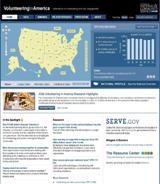 The economic crisis continues to test the nation’s ability to support some of the most vulnerable populations. Leaders across the nation are responding by rallying Americans to use service as a solution in addressing these challenges., New research at VolunteeringInAmerica.gov shows that despite all the additional stresses of a difficult economy, the nation experienced the largest single-year increase in volunteering since 2003.
The economic crisis continues to test the nation’s ability to support some of the most vulnerable populations. Leaders across the nation are responding by rallying Americans to use service as a solution in addressing these challenges., New research at VolunteeringInAmerica.gov shows that despite all the additional stresses of a difficult economy, the nation experienced the largest single-year increase in volunteering since 2003.
Volunteering in America 2009: State and City Trends and Rankings
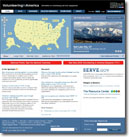 VolunteeringInAmerica.gov hosts the most comprehensive collection of data on volunteering and civic engagement ever assembled, including data for every state and almost 200 cities. The data is collected through a partnership with the U.S. Census Bureau and the Bureau of Labor Statistics, and has been released annually since 2005. This year, data show that despite the onset of an economic recession during 2008, volunteering rates held steady at 26.4 percent compared to last year’s 26.2 percent. Additionally, more Americans are engaging in their community in less formal ways—2008 saw a 31 percent increase in the number of people who reported that they worked with their neighbors to solve a community problem, and 17 percent more people attended community meetings.
VolunteeringInAmerica.gov hosts the most comprehensive collection of data on volunteering and civic engagement ever assembled, including data for every state and almost 200 cities. The data is collected through a partnership with the U.S. Census Bureau and the Bureau of Labor Statistics, and has been released annually since 2005. This year, data show that despite the onset of an economic recession during 2008, volunteering rates held steady at 26.4 percent compared to last year’s 26.2 percent. Additionally, more Americans are engaging in their community in less formal ways—2008 saw a 31 percent increase in the number of people who reported that they worked with their neighbors to solve a community problem, and 17 percent more people attended community meetings.
The detailed information in the report is designed to help national, state and local leaders better understand volunteering trends and demographics and use the data to develop effective strategies for recruiting and retaining volunteers.
Community Service and Service-Learning in America's Schools
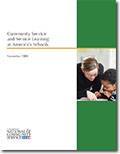 In the spring of 2008, 1,847 principals of K-12 public schools, nationwide, responded to a survey on the prevalence of community service and service-learning in their schools. The National Study of the Prevalence of Community Service and Service-Learning in K-12 Public Schools collected data on the scope of community service and service-learning activities, as well as the policies and supports for service-learning provided by and for schools during the 2007-08 academic year.
In the spring of 2008, 1,847 principals of K-12 public schools, nationwide, responded to a survey on the prevalence of community service and service-learning in their schools. The National Study of the Prevalence of Community Service and Service-Learning in K-12 Public Schools collected data on the scope of community service and service-learning activities, as well as the policies and supports for service-learning provided by and for schools during the 2007-08 academic year.
Reaching Our Goals: Research in Support of the Strategic Initiatives
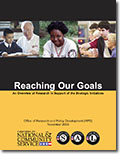 The Corporation is consistently releasing new research on volunteering and national service across the country. Reaching Our Goals synthesizes many of the key findings from the agency’s studies so that leaders in service can quickly and easily access a wide array of research findings specifically related to each of our strategic goals. This document is regularly updated to reflect the most current data available.
The Corporation is consistently releasing new research on volunteering and national service across the country. Reaching Our Goals synthesizes many of the key findings from the agency’s studies so that leaders in service can quickly and easily access a wide array of research findings specifically related to each of our strategic goals. This document is regularly updated to reflect the most current data available.
Volunteering in America 2008 - State and City Trends and Rankings
 Volunteering in America 2008 presents and analyzes the latest Census Bureau data on volunteer trends and demographics for all 50 states and 162 U.S. cities. Among the key findings: Nearly 61 million Americans volunteered in their communities in 2007, giving 8.1 billion hours of service worth approximately $158 billion to America’s communities. At the state level, Utah once again had the highest volunteer rate, at 43.9%, while Minneapolis-St. Paul, at 39.3%, topped the list of large cities with populations over one million. Additionally, Provo, UT ranks #1 among mid-size cities with an impressive volunteer rate of 63.8%.
Volunteering in America 2008 presents and analyzes the latest Census Bureau data on volunteer trends and demographics for all 50 states and 162 U.S. cities. Among the key findings: Nearly 61 million Americans volunteered in their communities in 2007, giving 8.1 billion hours of service worth approximately $158 billion to America’s communities. At the state level, Utah once again had the highest volunteer rate, at 43.9%, while Minneapolis-St. Paul, at 39.3%, topped the list of large cities with populations over one million. Additionally, Provo, UT ranks #1 among mid-size cities with an impressive volunteer rate of 63.8%.
The detailed information in the report is designed to help national, state and local leaders better understand volunteering trends and demographics and use the data to develop effective strategies for recruiting and retaining volunteers.
Two new analysis were also included with the release of VolunteeringInAmerica.gov:
Long-Distance Volunteering in America
In areas impacted by natural disasters, where local volunteers and nonprofit organizations are sometimes hard-hit themselves and unable to serve at full capacity, visiting volunteers are often indispensable. Since the hurricanes of 2005 devastated the Gulf area in the South, out-of-state volunteers have significantly bolstered the capacity of communities to continue on the path to recovery. In fact in 2007, about a quarter of all the volunteers serving in Mississippi traveled to serve from out-of-state, and the same is true for a fifth of all the volunteers serving in Louisiana. Altogether, about six percent of all volunteers age 16 and older do at least some long-distance volunteering, serving at least 120 miles away from their home communities. Read more.
How Do Volunteers Find the Time?: Evidence from the American Time Use Study
Not surprisingly, volunteers and non-volunteers in general tend to spend their time in very similar ways, including in work, leisure, and other activities. However, there are some important differences, such as the amount of time each of these groups spends watching television. On average, those who have never volunteered watch 436 more hours of television than volunteers each year. Read more.
Capitalizing on Volunteers’ Skills: Volunteering in America by Occupation
The Corporation continues to put a strong emphasis on pro bono volunteering as a strategic and cost-effective way to tap into the skills of volunteers and reinvent the way they serve with nonprofits. Capitalizing on Volunteers’ Skills looks at the prevalence of volunteering among people in various occupations and, for the first time, shows how often they use their occupational skills when they volunteer. The brief is designed to help broaden and deepen public and private sector partnerships, and allow nonprofits to take full advantage of the skills their volunteers have to offer.
2005-2006 Senior Corps Performance Survey Findings
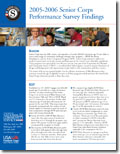 Senior Corps taps the skills, talents, and experience of nearly 500,000 Americans age 55 and older to meet a wide range of community challenges through three program — RSVP, the Foster Grandparent, and the Senior Companion Program (SCP). Senior Corps volunteers address the needs of communities across the country and help some of the nation’s most vulnerable populations. These programs have operated for over 40 years, and are now part of the Corporation for National and Community Service (CNCS) — an independent federal agency created to connect Americans of all ages and backgrounds with opportunities to give back to their communities and their country.
Senior Corps taps the skills, talents, and experience of nearly 500,000 Americans age 55 and older to meet a wide range of community challenges through three program — RSVP, the Foster Grandparent, and the Senior Companion Program (SCP). Senior Corps volunteers address the needs of communities across the country and help some of the nation’s most vulnerable populations. These programs have operated for over 40 years, and are now part of the Corporation for National and Community Service (CNCS) — an independent federal agency created to connect Americans of all ages and backgrounds with opportunities to give back to their communities and their country.
The results of the surveys provide helpful clues for effective recruitment of Baby Boomers as they continue to reach the age of eligibility to serve in all three programs and demonstrate the benefits that Senior Corps volunteers provide to those they serve.
Still Serving: Measuring the Eight-Year Impact of AmeriCorps on Alumni
May 2008
 Results from a rigorous evaluation of AmeriCorps show that AmeriCorps has long-term impacts on members’ years after they serve. From 1999 to 2008, we followed more than 2,000 individuals in AmeriCorps State and National and NCCC to look at the effect of service on their future civic engagement and volunteering, employment and careers, and educational attainment. Findings reveal that AmeriCorps is a pipeline to careers in public service and creates civic leaders who continue to serve in their communities long after their service has been completed.
Results from a rigorous evaluation of AmeriCorps show that AmeriCorps has long-term impacts on members’ years after they serve. From 1999 to 2008, we followed more than 2,000 individuals in AmeriCorps State and National and NCCC to look at the effect of service on their future civic engagement and volunteering, employment and careers, and educational attainment. Findings reveal that AmeriCorps is a pipeline to careers in public service and creates civic leaders who continue to serve in their communities long after their service has been completed.
Volunteering in America:
2007 City Trends and Rankings
 Volunteering in America: 2007 City Trends and Rankings supports our efforts to increase volunteering in communities by providing a first-time analysis of volunteer trends among major metropolitan (metro) areas. This report ranks and presents detailed profiles of volunteering for 50 of the largest metro areas in the United States. The information on volunteering at the local level can help local governments, community leaders, service organizations, and volunteers nationwide develop a volunteer growth strategy, set goals to increase the level of individual engagement in volunteer activities, and build the infrastructure of nonprofits and communities to support more volunteer opportunities.
Volunteering in America: 2007 City Trends and Rankings supports our efforts to increase volunteering in communities by providing a first-time analysis of volunteer trends among major metropolitan (metro) areas. This report ranks and presents detailed profiles of volunteering for 50 of the largest metro areas in the United States. The information on volunteering at the local level can help local governments, community leaders, service organizations, and volunteers nationwide develop a volunteer growth strategy, set goals to increase the level of individual engagement in volunteer activities, and build the infrastructure of nonprofits and communities to support more volunteer opportunities.
Improving Lives and Communities: Perspectives on 40 Years of Service
 For over 40 years, Volunteers in Service to America (VISTA) has provided members to serve in nonprofit, faith-based and other community organizations and public agencies across the nation to create and expand programs that bring low-income individuals and communities out of poverty. Improving Lives and Communities: Perspectives on 40 Years of Service provides insights into the experiences of VISTA members, starting with the program's inception in 1965 until VISTA merged with AmeriCorps and became the AmeriCorps VISTA program in 1993. The report focuses on VISTA members’ experiences and their civic engagement, education, employment, and the intergenerational transfer of values following their service in VISTA.
For over 40 years, Volunteers in Service to America (VISTA) has provided members to serve in nonprofit, faith-based and other community organizations and public agencies across the nation to create and expand programs that bring low-income individuals and communities out of poverty. Improving Lives and Communities: Perspectives on 40 Years of Service provides insights into the experiences of VISTA members, starting with the program's inception in 1965 until VISTA merged with AmeriCorps and became the AmeriCorps VISTA program in 1993. The report focuses on VISTA members’ experiences and their civic engagement, education, employment, and the intergenerational transfer of values following their service in VISTA.
AmeriCorps: Changing Lives, Changing America
A Report on AmeriCorps’ Impact on Members and Nonprofit Organizations
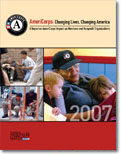 This report examines the results from a longitudinal study of AmeriCorps members and surveys of members, alumni, and the organizations where members served to examine the impacts of national service on members’ civic engagement, education, employment, and life skills. Findings reveal that AmeriCorps alumni are more connected to their communities, continue to participate in community activities, and choose public service careers after their service with AmeriCorps.
This report examines the results from a longitudinal study of AmeriCorps members and surveys of members, alumni, and the organizations where members served to examine the impacts of national service on members’ civic engagement, education, employment, and life skills. Findings reveal that AmeriCorps alumni are more connected to their communities, continue to participate in community activities, and choose public service careers after their service with AmeriCorps.
The Health Benefits of Volunteering:
A Review of Recent Research
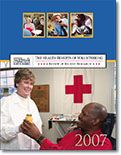 Over the past two decades we have seen a growing body of research that indicates volunteering provides individual health benefits in addition to social benefits. This research has established a strong relationship between volunteering and health: those who volunteer have lower mortality rates, greater functional ability, and lower rates of depression later in life than those who do not volunteer. Comparisons of the health benefits of volunteering for different age groups have also shown that older volunteers are the most likely to receive greater benefits from volunteering, whether because they are more likely to face higher incidence of illness or because volunteering provides them with physical and social activity and a sense of purpose at a time when their social roles are changing. Some of these findings also indicate that volunteers who devote a “considerable” amount of time to volunteer activities (about 100 hours per year) are most likely to exhibit positive health outcomes.
Over the past two decades we have seen a growing body of research that indicates volunteering provides individual health benefits in addition to social benefits. This research has established a strong relationship between volunteering and health: those who volunteer have lower mortality rates, greater functional ability, and lower rates of depression later in life than those who do not volunteer. Comparisons of the health benefits of volunteering for different age groups have also shown that older volunteers are the most likely to receive greater benefits from volunteering, whether because they are more likely to face higher incidence of illness or because volunteering provides them with physical and social activity and a sense of purpose at a time when their social roles are changing. Some of these findings also indicate that volunteers who devote a “considerable” amount of time to volunteer activities (about 100 hours per year) are most likely to exhibit positive health outcomes.
Volunteering in America:
2007 State Trends and Rankings in Civic Life
 Volunteering in America: 2007 State Trends and Rankings in Civic Life is the second annual study by the Corporation for National and Community Service that gives a detailed breakdown of America’s volunteering demographics, habits, and patterns by state and region. The 2007 report also provides the agency’s first-ever ranking of levels of civic engagement by state through a new Civic Life Index. This report is a valuable tool to help states and organizations increase volunteering towards the national goal of 75 million volunteers by the year 2010.
Volunteering in America: 2007 State Trends and Rankings in Civic Life is the second annual study by the Corporation for National and Community Service that gives a detailed breakdown of America’s volunteering demographics, habits, and patterns by state and region. The 2007 report also provides the agency’s first-ever ranking of levels of civic engagement by state through a new Civic Life Index. This report is a valuable tool to help states and organizations increase volunteering towards the national goal of 75 million volunteers by the year 2010.
Keeping Baby Boomers Volunteering:
A Research Brief on Volunteer Retention and Turnover
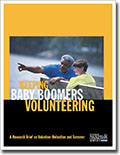 Baby Boomers today have the highest volunteer rate of any age group. They also, as this report notes, volunteer at higher rates than past generations did when they were the same age. While much attention has focused on how to recruit Baby Boomers into the ranks of volunteers, relatively little attention has been paid to ensuring that those who choose to volunteer one year continue to do so the next. Because three out of every ten Boomer volunteers choose not to volunteer in the following year, a key aspect of keeping Boomer volunteer rates high is to learn how to retain existing Boomer volunteers.
Baby Boomers today have the highest volunteer rate of any age group. They also, as this report notes, volunteer at higher rates than past generations did when they were the same age. While much attention has focused on how to recruit Baby Boomers into the ranks of volunteers, relatively little attention has been paid to ensuring that those who choose to volunteer one year continue to do so the next. Because three out of every ten Boomer volunteers choose not to volunteer in the following year, a key aspect of keeping Boomer volunteer rates high is to learn how to retain existing Boomer volunteers.
To better understand this dynamic, the Corporation for National and Community Service looked at data collected by the U.S. Census Bureau and Bureau of Labor Statistics from 2002-2006. The data trace the volunteer habits of the same sample of Baby Boomers over two consecutive years, as well as a similar sample of pre-Boomers. This is the first time that these data sets have been analyzed. Though much work remains to be done, the hope is that the findings contained herein will help nonprofits and others gain greater insight into the volunteer preferences of Baby Boomers so that turnover can be kept to a minimum and the greatest number of Boomers will remain engaged in their communities in their later years.
Volunteer Growth in America:
A Review of Trends Since 1974
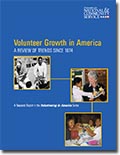 The Corporation has produced a national report that for the first time tracks volunteering over a 30-year period. “Volunteer Growth in America: A Review of Trends Since 1974” illustrates how volunteering has rebounded to a 30-year high today – rising by more than 32 percent over the past 16 years – after declining between 1974 and 1989. The report found that older teenagers (ages 16-19) have more than doubled their time spent volunteering since 1989; that far from being a “Me Generation,” that Baby Boomers are volunteering at sharply higher rates than did the previous generation at mid-life; and that the volunteer rate for Americans ages 65 years and over has increased 64 percent since 1974; and the proportion of Americans volunteering with an educational or youth service organization has seen a 63 percent increase just since just 1989.
The Corporation has produced a national report that for the first time tracks volunteering over a 30-year period. “Volunteer Growth in America: A Review of Trends Since 1974” illustrates how volunteering has rebounded to a 30-year high today – rising by more than 32 percent over the past 16 years – after declining between 1974 and 1989. The report found that older teenagers (ages 16-19) have more than doubled their time spent volunteering since 1989; that far from being a “Me Generation,” that Baby Boomers are volunteering at sharply higher rates than did the previous generation at mid-life; and that the volunteer rate for Americans ages 65 years and over has increased 64 percent since 1974; and the proportion of Americans volunteering with an educational or youth service organization has seen a 63 percent increase just since just 1989.
“Volunteer Growth in America” is based on statistics from the U.S. Census Bureau and the Bureau of Labor Statistics. The findings are encouraging while demonstrating that more engagement is needed to achieve a national goal of raising the number of volunteers from 65 million in 2005 to 75 million by 2010.
College Students Helping America
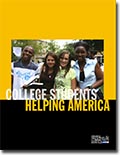 The Corporation has produced the most comprehensive national report ever conducted on college student volunteering in the United States. “College Students Helping America” concludes that college student volunteering increased by approximately 20 percent between 2002 and 2005, as students have become involved in helping their communities. The report presents data on student volunteering and volunteers in an easily accessible format that will be useful to people—whether experienced researchers, policy makers, or just concerned citizens—interested in learning more about volunteering in the states.
The Corporation has produced the most comprehensive national report ever conducted on college student volunteering in the United States. “College Students Helping America” concludes that college student volunteering increased by approximately 20 percent between 2002 and 2005, as students have become involved in helping their communities. The report presents data on student volunteering and volunteers in an easily accessible format that will be useful to people—whether experienced researchers, policy makers, or just concerned citizens—interested in learning more about volunteering in the states.
“College Students Helping America” is based on statistics from the U.S. Census Bureau and the Bureau of Labor Statistics. The report includes a state-by-state ranking of college student volunteering.
Volunteers Mentoring Youth: Implications for Closing the Mentoring Gap
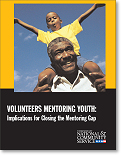 To develop a greater understanding of the characteristics and traits that distinguish individuals whose volunteering includes mentoring youth from volunteers who do not mentor, the Corporation for National and Community Service conducted a close analysis of the 2005 Volunteer Supplement of the Current Population Survey (CPS). Corporation researchers examined whether demographic, socioeconomic, or other observable factors could be used to distinguish between volunteers who mentor and the general population of volunteers who do not mentor, as well as to determine which of the above factors are most influential in predicting who is most likely to be engaged in mentoring activities. The expectation is that the information gleaned will help mentoring programs better identify and recruit the types of individuals who are most likely to be favorably disposed toward mentoring, and thereby help to reduce the “mentoring gap.”
To develop a greater understanding of the characteristics and traits that distinguish individuals whose volunteering includes mentoring youth from volunteers who do not mentor, the Corporation for National and Community Service conducted a close analysis of the 2005 Volunteer Supplement of the Current Population Survey (CPS). Corporation researchers examined whether demographic, socioeconomic, or other observable factors could be used to distinguish between volunteers who mentor and the general population of volunteers who do not mentor, as well as to determine which of the above factors are most influential in predicting who is most likely to be engaged in mentoring activities. The expectation is that the information gleaned will help mentoring programs better identify and recruit the types of individuals who are most likely to be favorably disposed toward mentoring, and thereby help to reduce the “mentoring gap.”
Youth Helping America Series
In collaboration with the U.S. Census Bureau and the nonprofit coalition Independent Sector, the Corporation for National and Community Service in early 2005 conducted the Youth Volunteering and Civic Engagement Survey, the first major national study of volunteering by teenagers in more than a decade. The first brief based on the survey’s data explores the state of youth volunteering and the connections between youth volunteering and the primary social institutions to which teenagers are exposed – family, schools, and religious congregation. Among other findings, the analysis shows that the state of youth volunteering is robust – with 55% of youth participating in volunteer activities each year – and that the level of their volunteer commitment is directly related to the nature of the social institutions with which they interact. The second brief takes a closer look at the 38 percent of students nationwide – some 10.6 million students in total -- who ever participated in school-based service as part of school activity or requirement, and it constructs a Service Quality Index that rates school-based service based on the level of high-quality service-learning elements that are incorporated into it.
Brief 2:
Educating for Active Citizenship: Service-Learning, School-Based Service, and Civic Engagement
Brief 1:
Building Active Citizens: The Role of Social Institutions in Teen Volunteering
Serving Country and Community: A Longitudinal Study of Service in AmeriCorps
Updated April 2007
Results from a longitudinal study of AmeriCorps members demonstrate the early impacts of national service on members’ civic engagement, education, employment, and life skills. Findings reveal that AmeriCorps alumni are more connected to their communities, more knowledgeable about problems facing their communities, and more likely to participate in community activities. They also are more likely to choose public service careers.
We are pleased to announce the first public release of longitudinal data from the report entitled Serving Country and Community: A Longitudinal Study of Service in AmeriCorps. The datasets are being made available to researchers and practitioners who are interested in studying the effects of participating in AmeriCorps and of volunteering and service.
Survey of Volunteering in the United States
The Volunteering in the United States survey has collected annual, national-level data on the prevalence of volunteering and the characteristics of volunteers since 2002. At the request of the Corporation, the U.S. Census Bureau and the Bureau of Labor Statistics (BLS) have administered the survey as a supplement of the Current Population Survey, a monthly survey of approximately 60,000 households that gathers information on employment and unemployment among the nation’s civilian noninstitutional population, age 16 and over. The Corporation plans to continue to fund the survey annually in order to gather important information on volunteering trends in the United States.
Additional Research and Analysis